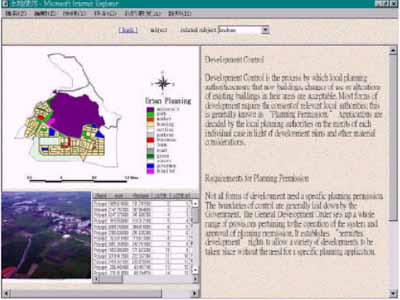| GISdevelopment.net ---> AARS ---> ACRS 2000 ---> GIS & Data Integration |
A case - based urban planning
support system using an integrated combination of Geographical Information
Systems and Remote Sensing
Ko-Wan Tsou, Yao-Lin Chang*, Yu -Ting Hung*
Associate professor, *Candidate of Dr. Degree
Department of Urban Planning,
National Cheng-Kung University, Tainan, Taiwan
Tel: (886)6-2757575#54232; Fax: (886)6-2754943
Email: uptkw@mail.ncku.edu.tw, yaolin@ntcp.up.ncku.edu.tw, eva@ntcp.up.ncku.edu.tw
Ko-Wan Tsou, Yao-Lin Chang*, Yu -Ting Hung*
Associate professor, *Candidate of Dr. Degree
Department of Urban Planning,
National Cheng-Kung University, Tainan, Taiwan
Tel: (886)6-2757575#54232; Fax: (886)6-2754943
Email: uptkw@mail.ncku.edu.tw, yaolin@ntcp.up.ncku.edu.tw, eva@ntcp.up.ncku.edu.tw
Key Words: Case-based urban planning support system (CBUPSS), GIS
Abstract
Case-based support system (CBSS) is an innovated knowledge-based system (KBS). CBSS makes data more accessible by organizing it as a set of examples from past experience that can be generalized and applied to current problems. CBSS has been successfully applied to a wide variety of domains, including systems for architectural design, site planning, environmental design, and engineering structural design. This paper proposes a conceptual framework for developing case-based urban planning support system (CBUPSS) that can structure and retrieve old cases accurately and efficiently. The conceptual framework employs a combination of GIS and RS to structure spatial case information and provide experiential planning solutions. The usefulness evaluation of historical cases is further carried out by the comparison of original spatial plan and recent land use pattern. The RS imagery is used to map recent land use pattern. Furthermore, we build a prototype CBUPSS to demonstrate the implementation of the conceptual framework.
1. Introduction
Most current KBS for urban planning are limited to deal with its well-structured aspect and fall short in dealing with flexibility and fuzziness in the alternative design. Case-Base Reasoning (CBR) was suggested as a promising way to overcome the difficulties in applying KBS to urban planning (Shi & Yeh, 1999). The fundamental philosophy of CBR is to use previous similar cases to solve problems or design new cases. Furthermore, rather than dismantling expert knowledge, this system emphasizes solving ill-structured problems on the basis of previous case study. It can, thus, partly improve the restriction on the knowledge expression of the conventional KBS. CBSS are a type of KBS based on CBR. CBSS also assume that people tend to adopt previous problem-solving pattern as the ground base and then make appropriate modifications to tackle new problems. In retrospect, the general planning practice emphasizes the significance of planning experience. The nature of planning experience is an accumulation of case-based comparison. It has many similarities with the principle of CBSS. Therefore, this article has trying to construct a CBUPSS to support the work of alternative design in urban planning.
Moreover, we can see that in the historical development of support system the procurement of expertise is the key element to the success of system. On case-based support system, how to efficiently procure the case used by the expert to solve the problems and to control the behavior and pattern of the case used is the key point of system development. It also carries out survey analysis to planners by experimental approach to initially sum up the behavior design and presentation procedure of planning case procurement to the reference of virtual system construction.
3. Case Library and a Prototype System
3.1 Case Library
The case library is the knowledge base and core of a CBUPSS. Basically, the requirements for contents and information formats of urban planing case are complicated. The descriptions of themes like planning circumstances, plan alternatives, and plan evaluation except requiring text information, it also requires descriptions of photo images, charts, and related geographic information. More over, most of the planners are used to utilizing graphs to understand pertinent information and outcomes of planning sites. Therefore, case descriptions must combine texts with graphs.
The integrated- information of urban planning cases that offered by the combination of GIS and RS in the producing of graphs using artificial cut to mince the real world entity into pieces. This method adopts geometric objects (point, line, plane), topological relation, classification attribute and area image to accomplish case's description method. Features of planning cases can be categorized as:
- Describing attributes information of spatial characteristics of feature by statistical information.
- Describing spatial information and the degree of urban development obtained from the relativity of objects in the planning coverage and RS by users.
- Describing attributes information of non-spatial characteristics of feature mainly to express the significance of planning feature in planning.
- Describing relations of non-spatial characteristics of feature to elaborate non-spatial relationship with other features.
3.2.1 Searching for Reference Cases

Figure 2 The Compilation of Slot Search in the Prototype CBUPSS
3.2.2 The Representation of Searching Results

Figure 3 The Search Results of the Prototype CBUPSS
3.2.3 The Content Representation of Selected Cases

Figure 4 The Content Representation of the Prototype CBUPSS
4. Conclusions
This paper proposes a conceptual framework for developing CBUPSS that can structure and retrieve old cases accurately and efficiently. CBUPSS with a combination of GIS and RS to structure spatial case information are suggested as a promising way to overcome those difficulties in applying KBS to alternative design in urban planning.
5.Reference
- Reference for Journals: Shi, X. and Yeh, A. G. O., 1999, The integration of case- based systems and GIS in development control, Environment and Planning B: Planning and Design, 26, pp.345- 364.